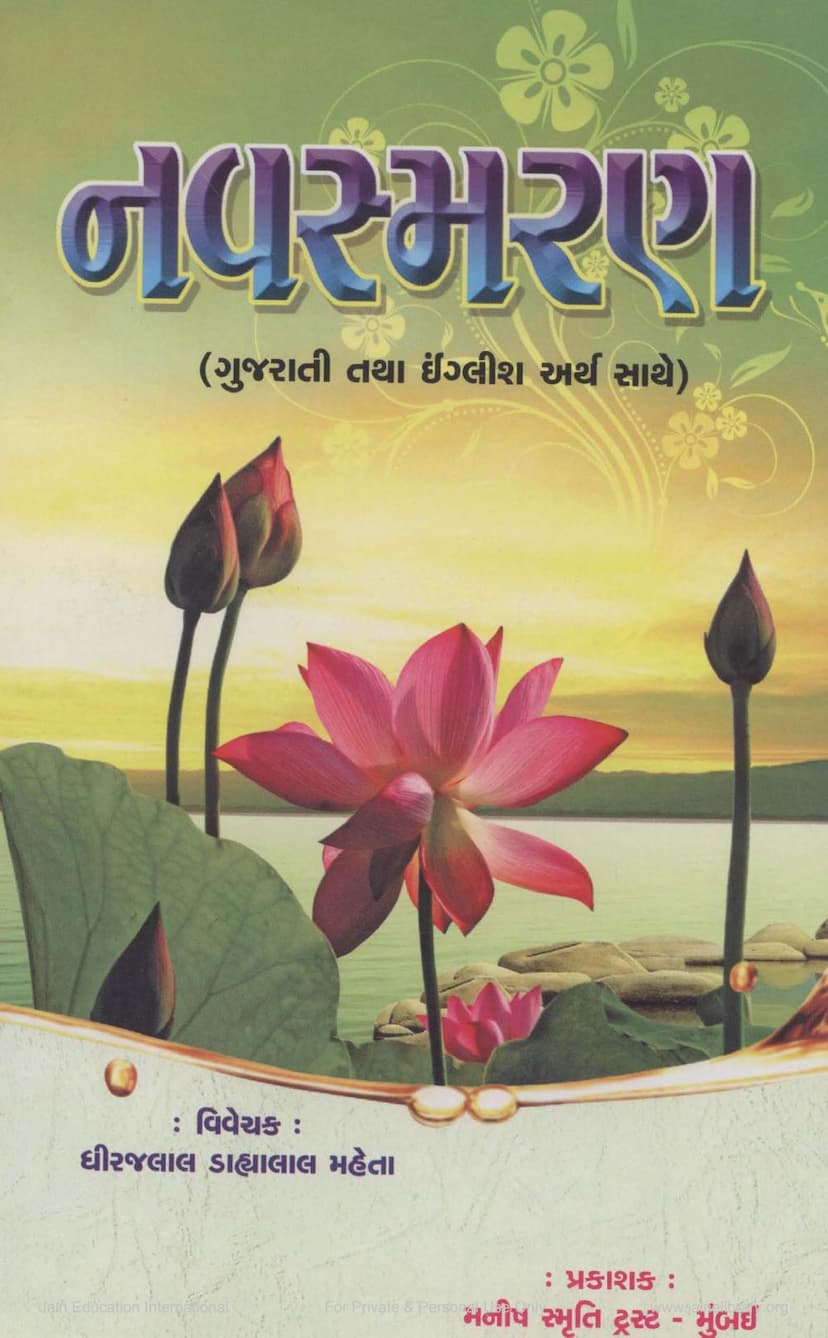Navasmarana
Added to library: September 2, 2025

Summary
This comprehensive summary details the Jain text "Navasmarana" (Nine Invocations), published by Manish Smruti Trust, Mumbai. The book, compiled and edited by Dhirajlal Dahyalaal Mehta and with English translation by Dr. Amritbhai Upadhya, presents nine powerful Jain stotras, each with its Gujarati and English original verses and explanations.
The book is dedicated to the spiritual development and well-being of the Jain community, aiming to make these influential prayers accessible to a wider audience, especially those familiar with English. The publishers express gratitude to Dr. Upadhya for his translation efforts and highlight the book's publication as a tribute to the late wife of Shri Dhirubhai Ratilal Shah, who cherished these verses. The work is presented as a bridge between classical Jain texts and the modern, English-speaking world, with hopes for further translations of other Jain scriptures.
Here's a breakdown of the nine invocations detailed in the book:
-
Namaskar Mahamantra: The foundational Pancha Namaskara Mantra, considered the most auspicious in Jainism. It's described as the "Pancha Mangal Mahashrutkandh" and credited with saving Amar Kumar from death. Its timeless nature, composed at the time of the formation of the twelve Angas, is emphasized.
-
Uvasaggaharam Stotra: A hymn dedicated to Lord Parshvanatha, authored by Acharya Bhadrabahuswami. Its creation was prompted by a plague that afflicted the Jain sangha, which was miraculously subdued by reciting this stotra. The stotra is noted for its 5 verses and 185 letters.
-
Santikar Stotra: Composed by Acharya Munisundersuri, this hymn is dedicated to Lord Shantinatha and was created to quell an epidemic in Delvada, Mewar. It is believed to ward off negative spiritual influences. While it has 14 verses, only 13 are recited due to the author's self-reference in the 12th verse and potential interpolation in the 14th.
-
Tijaypaha Stotra: The author, origin, and purpose of this mantra-filled stotra, which honors 170 Jinas within the "Adhai Dveepa" region, are unknown. It is associated with the "Sarvatobhadra" yantra, a mystical diagram whose numerical arrangements are said to represent the 170 Tirthankaras. The text delves into the meanings of various seed mantras used in the yantra.
-
Namiuna Stotra: Authored by Acharya Mantungasuri of the Brihadgachha, this hymn in praise of Lord Parshvanatha addresses eight fears (disease, water, fire, serpents, thieves, lions, elephants, and war). Its recitation is believed to provide protection from these dangers. The author is also credited with the famous Bhaktamar Stotra.
-
Ajitashanti Stotra: This invocation praises Lords Ajitanatha and Shantinatha, and is attributed to Rishi Nandishena, an Agamadhara from the time of Lord Mahavir. The Rishi composed it while on pilgrimage to Shatrunjay mountain. The text notes that Nandisena was a disciple of Lord Neminatha and that the stotra is in Prakrit with distinct regional influences in its verses.
-
Bhaktamar Stotra: Authored by Acharya Mantungasuri, this renowned stotra's creation is linked to a dramatic event in the court of King Bhoj. Facing a challenge from scholars and imprisonment, Mantungasuri composed the 24 verses of the Bhaktamar Stotra, with each verse breaking a lock and chain, ultimately freeing him and converting the king to Jainism.
-
Kalyanmandir Stotra: Composed by Acharya Siddhasen Divakar, a disciple of Acharya Vriddhavadisuri. The story behind its creation involves a significant event where reciting the 11th verse caused the earth to shake and a hidden idol of Lord Parshvanatha to be revealed, leading to the conversion of King Vikramaditya and many kings.
-
Bruhatchhanti Stotra: The authorship is debated, with possibilities including Acharya Shantisuri (due to the frequent use of the word "Shanti") or Shivadevi, the mother of Lord Neminatha. However, the latter is considered unlikely due to the historical timeline and the stotra being in Sanskrit, with only one verse in Prakrit. The text also discusses the significance of the stotra for peace and well-being.
The book concludes with a detailed table of contents listing the page numbers for each of the nine invocations. It also includes a biographical sketch of Dr. Amritbhai Upadhya, highlighting his academic achievements and extensive experience in teaching and writing in English, Hindi, and Gujarati. The publisher's note emphasizes the enduring relevance of Navasmarana in contemporary society and encourages its widespread adoption for spiritual upliftment. The book's publication marks a significant effort to make these sacred Jain prayers accessible and understandable to a global audience.